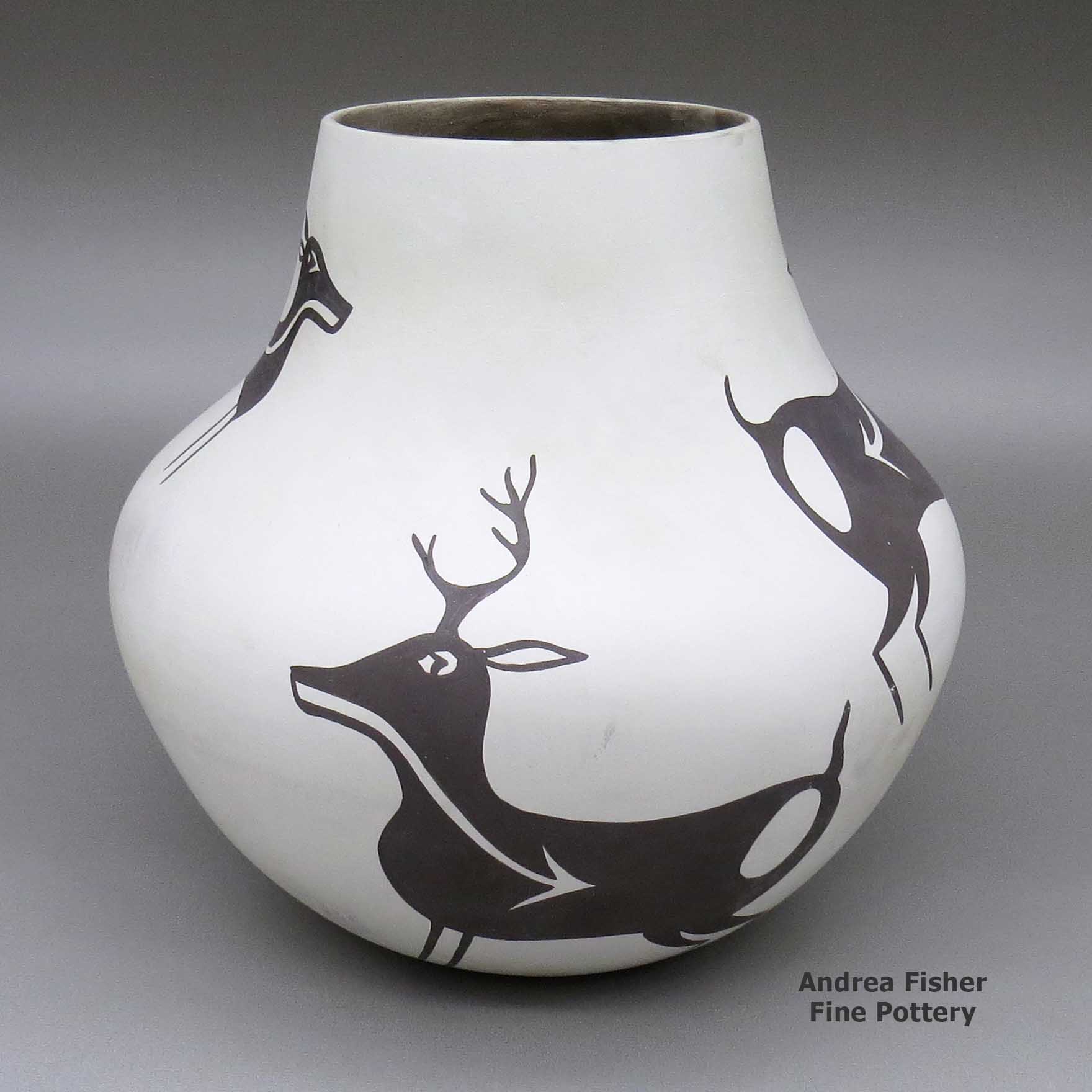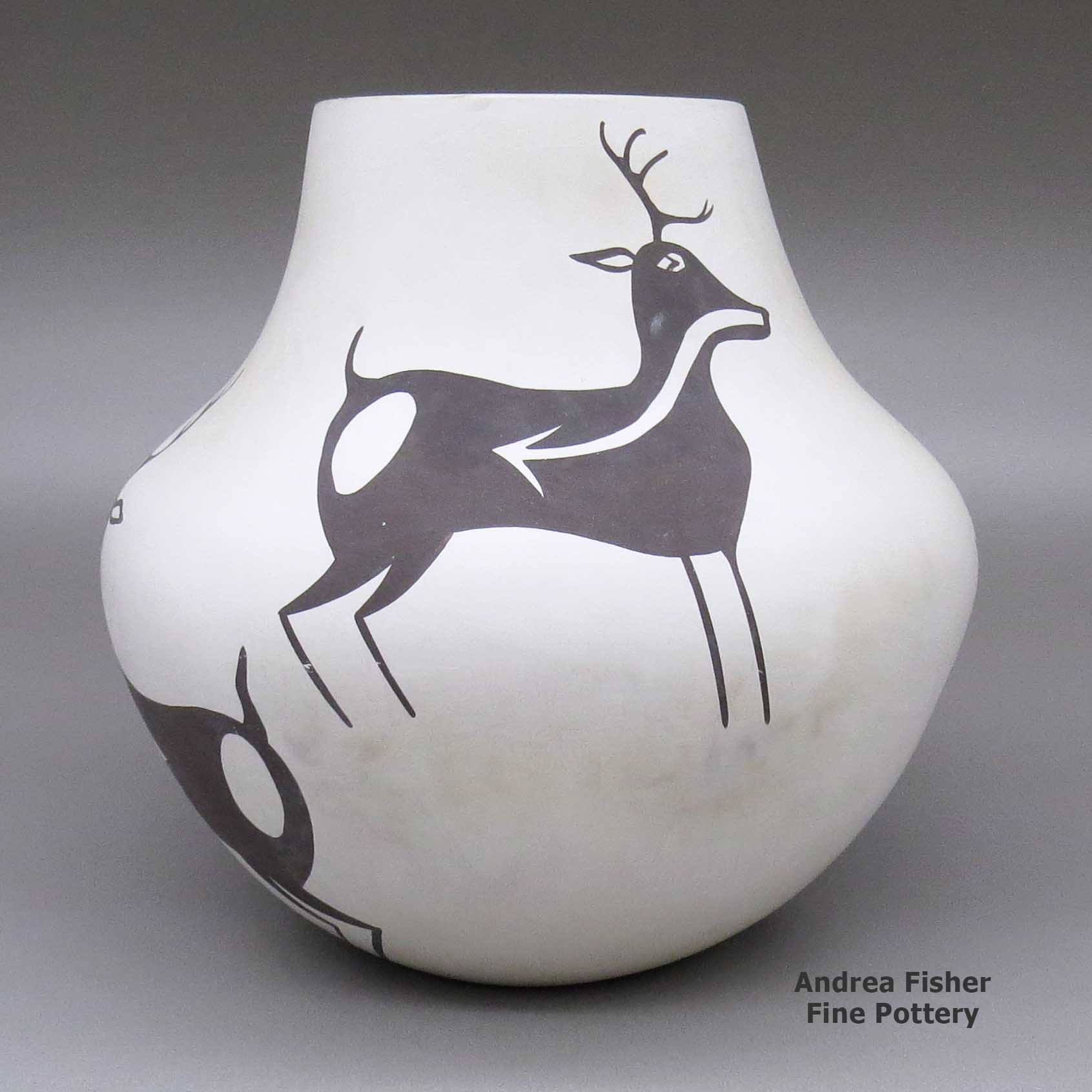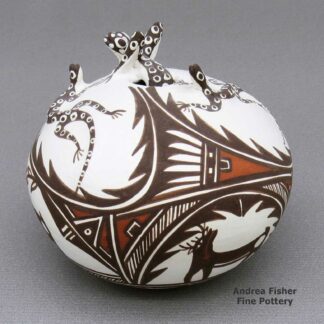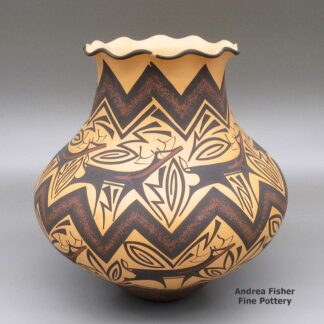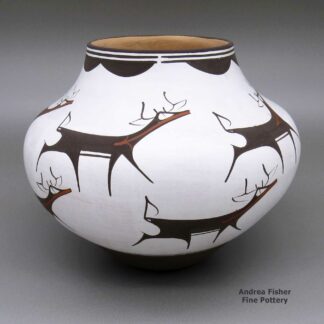| Dimensions | 8.25 × 8.25 × 8.25 in |
|---|---|
| Condition of Piece | Very good, normal wear |
| Signature | Alan E. Lasiloo |
Alan Lasiloo, zzzu3b517, Jar with a deer-with-heart-line design
$795.00
A black and white jar decorated with a deer-with-heart-line design
In stock
Brand
Lasiloo, Alan
From there he went to the American College for the Applied Arts in Los Angeles to study fashion design. Then he returned to Zuni in 1999 and began the journey to becoming a potter.
First he had to recall what he'd learned from his grandmother so many years before. Then he spent years experimenting with his process. He learned how to turn a "mistake" into a centerpiece. He learned different ways to fire his pottery. He learned how to enhance streaking and make that part of his design.
As he puts it: "I try to utilize what I have learned about fashion design by using lines, curves and pleats in my clay sculptures. This creates movement and brings life to the pieces."
Alan first entered the Santa Fe Indian Market in 2007 and earned red and blue ribbons that year for a couple of his pieces. He works a lot with Zuni white clay but also uses golden micaceous slips.
Some of Alan's work is in the Heard Museum object collection.
A Short History of Zuni Pueblo
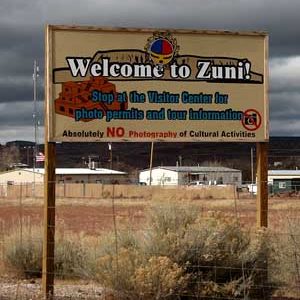
"K'ynánas'tipe stretched his legs to the four great seas, then gradually he settled down and called out, 'where my heart and navel rest, beneath them mark the spot and build your town there for that shall be the midmost place of Mother Earth.' As he squatted over the middle of the plain and the valley Zuni, he drew in his legs and his feet marked the trails leading outward like the radiating web of a spider. The fathers of the people built on this spot and rested their fetishes there." - Frank H. Cushing, Outlines of Zuni Creation Myths, pp. 428-9
Archaeologists have dated some sites on the Zuni Reservation back to the Paleo-Indian Period, more than 4,500 years ago. During the Archaic Period (2,500 BCE to 0 CE), the forebears of the Zuni were hunter-gatherers and just beginning to develop agriculture. The Basketmaker Period (0 CE to 700 CE) saw agriculture become more developed and the Zunis make their first pottery. The Pueblo I Period (700 CE to 1100 CE) saw an expansion of the population and larger settlements were built in the Zuni River area along with the development of the first painted Zuni pottery.
The Pueblo III Period (from 1100 to 1300 CE) saw further population growth in the Zuni River area and a shift from small houses to larger, plaza-oriented villages. The Pueblo IV Period (1300 to 1500 CE) was the time of significant bad weather, great drought and the beginning of the flood of Athabascans and Utes. Many tribal groups were forced out of the Four Corners area and relocated to locations near the Rio Grande, Rio Puerco, Zuni River and Little Colorado River. The main Zuni Pueblo was founded during this time but there were several other large villages in the area, too.
In 1540 Francisco Vasquez de Coronado arrived at the gates of Hawikuh, at the time one of the larger of seven Zuni pueblos. He first approached the pueblo at the end of a four-day religious festival. The Zuni chief had spilled a line of corn meal across the ground before the entrance to the pueblo, meant to signify to the Spanish that they shouldn't cross the line and enter the village yet. Coronado interpreted that line of corn meal as an act of war and immediately ordered his soldiers to attack.
Coronado was almost killed in the fighting (Zuni warriors had dropped a large rock on him, knocking him off his ladder and almost crushing him) but his soldiers did finally win the battle. As Coronado and his men brought horses and sheep with them, they were probably the first such livestock the Zunis had ever seen. The gold the Spaniards were looking for: it turned out to be Sikyátki Polychrome bowls and jars, yellow clay gifts from the Hopi people to the Zuni people.
The Zuni chief did give Coronado a refugee from the Plains tribes, someone who'd somehow made his way as a lone traveler to Hawikuh. That refugee was supposed to be a guide for Coronado and his men but he was instructed by the Zuni chief to take Coronado into the Plains and get him lost there. When Coronado finally realized that, more than a year later, he ordered the guide executed, then turned his men around and headed back to Zuni and Mexico.
When he passed by Zuni in 1542, Coronado left three Mexican Indians behind with the tribe. They most likely informed the tribal leaders of the extent of the Spanish domain in Mexico and the power they exercised there.
Except for a couple passing exploratory expeditions, the Zuni pueblos were left alone until the 1620s. Then came the friars who oversaw the construction of a mission church at Hawikuh in 1629. At first the Zuni people were friendly with the priests but with the forced labor requirements and forced religious conversions, the priests wore that welcome out quickly. Relations had changed drastically for the worse by the time of the Pueblo Revolt of 1680. Zuni warriors killed the priests and burned the missions but they preserved the relics and icons the priests had brought from Spain.
The tribe built a village near their fortress atop Dowa Yalanne and prepared to defend their people and way of life against the Spanish army. When Don Diego de Vargas arrived with troops in 1692, he attacked the fortress twice and failed. Then he negotiated with the Zuni war chief and was allowed to ascend to the top of Dowa Yalanne. He was given a tour of the property and he found many relics from the destroyed missions there. With that knowledge, he arranged a peace between the Spanish and the tribe. Between 1693 and 1700 the tribe consolidated all their small villages into what is now the Pueblo of Zuni.

Photo courtesy of Ken Lund, Creative Commons Attribution-Share Alike License 2.0 Generic
Traditional Zuni Designs
Anthropologists say the Zuni people have been isolated for so long, there are no referrents to where their language came from. The images they paint on pottery, though, show some signs of cross-pollination with the Hopi, Acoma, Laguna and some of the Rio Grande pueblos.
Among those images are the heart-line, as in deer-with-heart-line. At some pueblos, that has become bear-with-heart-line and antelope-with-heart-line. Sometime around 1890, a Laguna potter made the journey to Zuni to learn from a potter there how to make better pottery. He stayed only a few months before returning to Laguna, via Acoma. He brought back better knowledge of mixing the clay, making the paints and painting the designs. Among those designs was the deer-with-heart-line.
At the time of first Spanish contact, there were seven Zuni pueblos spread out along the Zuni River. By about 1720, that was reduced to one. When the American archaeologists arrived, they set about excavating almost every abandoned village they could find. In the process, many pieces of ancient pottery came to light. That's where the names Matsaki Polychrome and Red-on-buff (matte paint on white and red slips, produced from about 1375 CE to about 1700 CE), Kwakina Polychrome (glaze paint on a white slip, produced from about 1325 to about 1400) and Heshotauthla Black-on-red and Polychrome (glaze decorations, produced from about 1275 to about 1400) came from. A primary difference between Kwakina and Heshotauthla designations is the color the inside of the bowl is slipped with. The decorations on both are painted with lead glaze colors and are taken from the same design library, which includes many designs common to the Mogollon Highlands in eastern Arizona (such as St. Johns Polychrome), although the designs tend to be not as well executed.
The advent of Matsaki Polychrome and Red-on-buff coincides with the entrance of an immigrant community from the north: the land of the Hopi. With them came the basic design library of what we now refer to as "Sikyatki Polychrome." Production of Kwakina- and Heshotauthla-style pottery dropped off quickly after the arrival of those who produced the Matsaki styles. It was around that time, too, that the Zuni villages around the Zuni Mountains were abandoned and the people pulled back to the pueblos along the lower Zuni River.
After Spanish contact and conquest, the Zunis were reduced to about one-tenth their population by Spanish diseases and labor practices. Before too long, they were gathered together in one village near the bank of the Zuni River. Their image catalog changed, too. When the American archaeologists and ethnologists came, they removed virtually every artifact of Zuni history they could dig up or find otherwise. Then they spirited it all away to storerooms on either coast, where most of it remains in boxes in dingy basement rooms today.
In 1986, Josephine Nahohai and several members of her family traveled to Washington DC and explored the basement storage shelves of the Smithsonian Institute, copying every ancient Zuni shape and design they found into their notebooks. When they returned to Zuni, their drawings became the basis for many of what are now referred to as traditional Zuni designs. Among those designs are symbols for mountains and forest, and images of frogs, tadpoles, dragonflies, serpents and rainbirds. Other Zuni potters have since visited other storerooms of ancient Zuni pottery and brought drawings of those shapes and designs back to the pueblo, too.
About Jars
The jar is a basic utilitarian shape, a container generally for cooking food, storing grain or for carrying and storing water. The jar's outer surface is a canvas where potters have been expressing their religious visions and stories for centuries.
In Sinagua pueblos (in northern Arizona), the people made very large jars and buried them up to their openings in the floors of the hidden-most rooms in their pueblo. They kept those jars filled with water but also kept smaller jars of meat and other perishables inside those jars in the water. It's a form of refrigeration still in use among indigenous people around the world.
Where bowls tend to be low, wide and with large openings, jars tend to be more globular: taller, less wide and with smaller openings.
For a potter looking at decorating her piece, bowls are often decorated inside and out while most jars are decorated only on the outside. Jars have a natural continuity to their design surface where bowls have a natural break at the rim, effectively yielding two design surfaces on which separate or complimentary stories can be told.
Before the mid-1800s, storage jars tended to be quite large. Cooking jars and water jars varied in size depending on how many people they were designed to serve. Then came American traders with enameled metal cookware, ceramic dishes and metal eating utensils...Some pueblos embraced those traders immediately while others took several generations to let them and their innovations in. Either way, opening those doors led to the virtual collapse of utilitarian pottery-making in most pueblos by the early 1900s.
In the 1920s there was a marked shift away from the machinations of individual traders and more toward marketing Native American pottery as an artform. Maria Martinez was becoming known through her exhibitions at various major industrial fairs around the country and Nampeyo of Hano was demonstrating her art for the Fred Harvey Company at the Grand Canyon. The first few years of the Santa Fe Indian Market helped to solidify that movement and propel it forward. It took another couple generations of artists to open other venues for their art across the country and turn Native American art into the phenomenon it has become.
Today's jars are artwork, not at all for utilitarian purposes, and their shapes, sizes and decorations have evolved to reflect that shift.
About the Deer-With-Heart-Line Design
The "deer-with-heart-line" pattern may have been developed by the potters of ancient Hawikuh. We don't know, but whenever it was developed, a Zuni Pueblo potter known as We'Wha taught it to Arroh-ah-och of Laguna Pueblo in the 1890s and Arroh-ah-och took it back to Laguna and painted it there.
Some potters at Acoma Pueblo were painting the image of a deer in the 1880s but no one painted the deer-with-heart-line design until Lucy Lewis asked for and received permission from the Pueblo of Zuni. Some members of her family have been painting it since but the design hasn't spread through the community like it has through Zuni.
The "heart line" has multiple meanings: it's a prayer of thanks for good health and abundance for the spirit of the deer and good hunting for the hunter.
When the "deer-with-heart-line" pattern appears under the center of a rainbow with mountain and forest symbols on either side, that is "deer-in-his-house," a prayer for abundance and prosperity for all in the environment.
